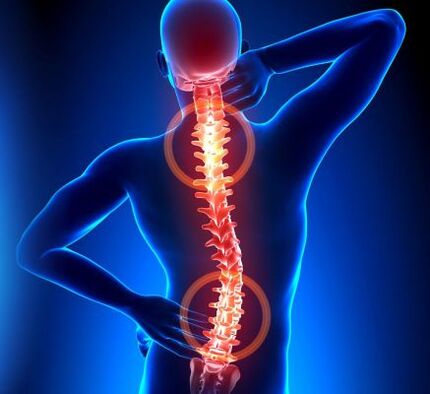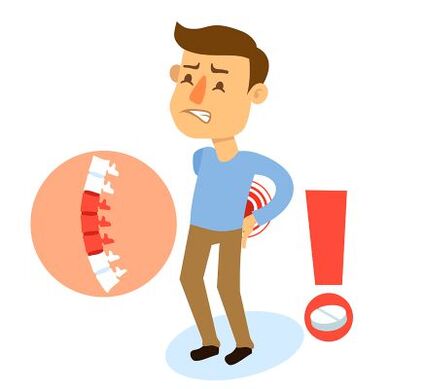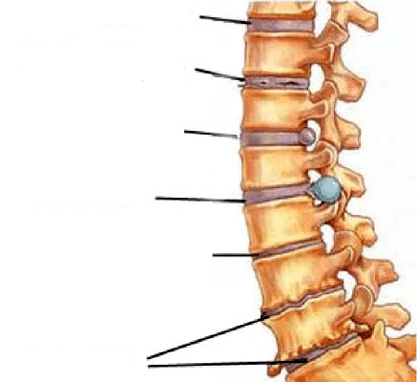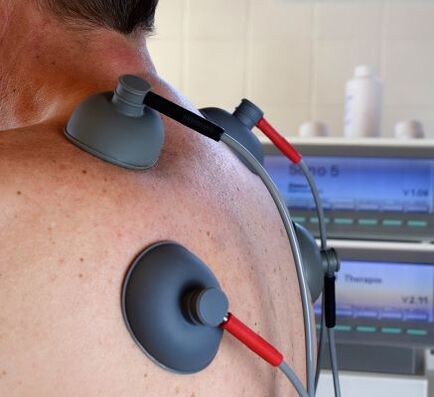Just imagine, in the 21st century, osteochondrosis is diagnosed in 50-80% of the world's population. The number is not small, and most importantly, the disease is "getting younger. " If earlier the first symptoms appeared no earlier than 35 years, now the first signs are diagnosed already in adolescents. Often, a predisposition to osteochondrosis is observed in people with uneven load on the spine. These can be incorrect posture, the habit of carrying a bag on one shoulder, sitting too long in one position, injuries, excessive sports loads and, of course, age -related changes.
"Most people have certainly heard of osteochondrosis, but not everyone knows what it is"
What is osteochondrosis?

Osteochondrosis is a pathology of the spine, expressed by degenerative damage to the intervertebral disc and nearby bone tissue, resulting in the removal of the vertebral body and joint surfaces.
Unfortunately, when the first pain in the back appears, almost no one goes to the doctor, this leads to the fact that the disease is detected already at a serious level. The disease in the early stages is treated quite effectively, because the changes in the spine are not critical, but over time the process becomes irreversible.
The main sign that you may have osteochondrosis is pain in the neck, back or lower back. In more advanced forms, pain "radiates" to the chest, arms, shoulders, legs and other parts of the body.
Depending on its location, osteochondrosis is divided into several types:
- Cervical osteochondrosis.
- Osteochondrosis of the chest.
- Lumbar osteochondrosis.
Symptoms and signs of osteochondrosis
Clinical manifestations arise from damage to nerve tissue and blood vessels located near the affected area.
- Backache.
- Feeling of "lumbago" after physical exercise.
- Poor posture and, consequently, scoliosis.
- Violation of skin sensitivity in certain areas of the body.
- Numb.
- Dizziness and nausea due to disruption of blood supply.
- Headache.
Osteochondrosis can have a variety of symptoms and signs, which is why it is not easy to detect it at the first signal. Perform regular checkups and do not delay seeing a doctor at the first suspicion of osteochondrosis.
Causes of osteochondrosis

There are many reasons for the development of osteochondrosis. As a rule, lack of proper respect for the spine causes this disease, if not at a young age, then certainly at the age of 50 years.
Think about how you sit every day, how you sleep, whether you have a comfortable pillow and whether you always carry a load in one hand, whether you give the right load when exercising, as all of these can lead to irreversible consequencesin your spine. . .
The reasons for the development of osteochondrosis can be:
- Genetic predisposition.
- Nervous body fatigue.
- Poor posture during active growth.
- Wear uncomfortable shoes.
- Wear heels at an early age.
- Physical overtraining of the body.
- Overweight.
- Inactive and inactive lifestyle.
- Improper weighting.
- Frequent load lifting.
- Vibration burdens the body.
- Body dehydration.
- Body hypothermia.
"Note that being overweight and inactive will cause back problems over time! "
At risk:
- Driver.
- Office staff.
- Activator.
- Pregnant lady.
- Obesity.
- Professional athlete.
Take care of your health and lead a healthy lifestyle.
The stage of development of osteochondrosis

No disease starts suddenly and immediately. Osteochondrosis is no exception. There are 4 main stages in the development of osteochondrosis.
- Changes in primary dystrophy of the intervertebral cartilage. Disc dehydration, microcracks, loss of elasticity - all of these are already happening in your spine while you practically don’t feel any change, but it’s still there and you can see it. If you start to feel uncomfortable during long sitting or minor pain after exercising physically, do not waste time, make an appointment with a doctor.
- Contraction of the intervertebral space and pinching of nerve endings and the appearance of pain in certain areas of the back. Pain syndrome will appear each time with a sharp rotation and tilt. This level is hard to miss and certainly not to be overlooked.
- Abrasions of intervertebral prone tissue. Pain symptoms are pronounced and can cause numbness in the limbs. It is impossible to get rid of pain without medication. At this stage, serious treatment is required by adhering to a regimen and taking medication.
- The last and most serious stage. Osteochondrosis on it is already irreversible, as the intervertebral cartilage is completely destroyed. Surgery is usually required in such cases.
More advanced cases of osteochondrosis can result in partial or complete paralysis. In order not to bring the condition to become critical, it is necessary to begin timely treatment in the first stage of development of osteochondrosis.
Treatment of osteochondrosis
For the treatment of spinal osteochondrosis, an individual approach is required for each patient. There is no standard and uniform method of treatment. The age of the patient, his physical condition, the cause of osteochondrosis and many other factors are taken into account. But of course, each treatment has common features:
Remedies for osteochondrosis

Osteochondrosis cannot be cured just by taking medication, but they play an important role in reducing the severity of disease symptoms, improving the process of blood supply and tissue regeneration. For the complete elimination of the disease, an integrated approach is required and the preservation of the state of the body in the right condition for the rest of your life. Medication for osteochondrosis consists of the intake of several groups of medications.
- First of all, it is necessary to get rid of the pain that interferes with a normal lifestyle. For this purpose, NSAIDs are used - non -steroidal anti -inflammatory drugs. (Ketoprofen, Ibuprofen, Ketorolac).
- Once pain symptoms are eliminated, chondroprotectors and vitamins are prescribed to restore cartilage tissue. Such drugs prevent the destruction of the intervertebral disc and reduce inflammation. Such drugs include Glucosamine, which, unlike analogues, does not need to be injected. Enough to dissolve one packet of powder in a glass of water and take it orally. This method of administration induces better absorption of the drug and relieves the discomfort that occurs during injection.
- Drugs that stimulate blood circulation in the blood.
- Local analgesics.
Physiotherapy for osteochondrosis

Treatment of osteochondrosis with physiotherapy is a fairly effective measure, and most importantly, it is not painful and has no contraindications. Such procedures help relieve inflammation, relieve cramps, and eliminate pinching of nerve endings. Physiotherapy includes procedures such as:
- Electrophoresis.
- Magnetotherapy.
- Phototherapy.
- Shock wave therapy.
- Mud therapy.
It should be noted that some physiotherapy procedures cannot be used during periods of exacerbation. Treatment of osteochondrosis with physiotherapy is prescribed exclusively by a physician and combined with drug treatment.
Physiotherapy and massage for osteochondrosis
Physiotherapy training for osteochondrosis helps form a muscular corset that will help support the diseased spine. Exercise sets were selected individually for each patient individually. For level 3, exercises are performed only while lying down, smooth and better under supervision.
Treatment of osteochondrosis with massage is also a common practice. The main thing is that the massage is done by a professional that will not harm your spine. After the session, you should feel muscle relaxation, clamp release and general relief. Manual massage improves blood circulation. In the acute period of the disease, it is better to refuse this method of treatment.
Treatment of cervical osteochondrosis

With osteochondrosis of the cervical spine, the patient feels severe pain in the head, neck, arms and shoulder girdle. There may be flickers of "flies", tinnitus and spots in front of the eyes. As a rule, in the early stages, the patient goes to examine the head and does not suspect that the matter is completely different. With cervical osteochondrosis is prescribed.
- Agnioprotectors against vertigo, which most often appear in the morning (Pentoxifylline).
- Chondroprotectors that prevent further destruction of cartilage tissue, reduce inflammation, relieve pain and restore joint mobility (Glucosamine, Chondroitin sulfate).
- Antidepressants, which are sometimes forced to be used by patients due to the fact that persistent pain has a detrimental effect on the psyche and contributes to the development of insomnia, depression (Doxylamin).
- Vitamins that will improve the general condition of the body.
- Anti-colvusants for headaches that disrupt the patient’s life completely.
- NSAIDs are prescribed in the acute period to relieve pain.
Treatment of chest osteochondrosis
With osteochondrosis of the thoracic spine, there is a sharp pain in the front of the chest, and breathing can become frequent and heavy. There may be a sharp pain when turning and bending in the shoulder blade area. It is difficult to diagnose thoracic osteochondrosis, because the pain is not felt directly in the spine, and the symptoms are more similar to heart, lung or kidney disease. Fortunately, this type of osteochondrosis is very rare and the cause of its occurrence is in most cases scoliosis.
Treatment of lumbar osteochondrosis
Lumbar osteochondrosis is the most common type at present. This is due to the fact that this part of the spine experiences the greatest stress. First, a dull pain appears in the lumbar region, then the pain begins to radiate to the legs and can cause numbness in the lower legs. Problems of bending and elongation arise. In such cases, the main thing is to start timely treatment of lumbar osteochondrosis and apply complex measures. Some rules must be followed:
- Limit physical activity.
- Take all prescribed medications.
- Undergo prescribed physiotherapy.
- Follow the typical sequence.
- Get rid of excess weight if necessary.
With improper treatment and non -adherence to recommendations, surgery may be required on the last lumbar osteochondrosis.
Which doctor treats osteochondrosis?
If you feel pain in the spine and suspect you have osteochondrosis, then you should initially make an appointment with a therapist, who, based on your complaint, will send you for examination to a neurologist, vertebrologist, orthopedist and surgeon.
How long is osteochondrosis treated?
Many patients are interested in how long osteochondrosis treatment will take? No one will give you an exact answer, but the main symptoms of the disease disappear, as a rule, in 1-3 months, further treatment is required.
Is it possible to get rid of osteochondrosis forever?
It all depends on the stage at which it is found. If the patient changes at level 1-2, then with proper treatment and adherence to all the rules, you can get rid of osteochondrosis forever. Unfortunately, it is impossible to get rid of this disease completely.
Orthopedic pillows
You may need an orthopedic pillow if you are diagnosed with cervical osteochondrosis. These pillows will improve the quality of your sleep and will not further damage your spine. You can contact a specialty store, where a consultant will show you all the options for pillows and give advice on prices.































